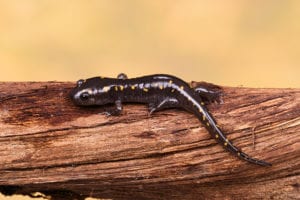Spotted Salamanders are one in a group referred to as Mole salamanders occurring in Eastern USA and Canada. They tend to occur in deciduous forests and wetlands, living in leaf litter, hiding in burrows or under fallen logs. Their breeding is very interesting, they return to water once a year, but only to temporary pools created by heavy rainfall. They only stay there for a few days to spawn, and do not swim strongly. These pools are perfect for salamander spawn and tadpoles to survive as temporary pools tend not to have fish that would eat them. However there are downsides to temporary pools, sometimes they dry up before metamorphosis is complete. It is now known that a symbiotic relationship occurs between a photosynthetic algae and the spawn / embryos of this species – this allows them to survive should the pools dry up too quickly. Clever stuff.
As with most salamanders, they are easy to maintain – however two major mistakes can be made. Firstly do not keep them too warm, anything above around 20C will result in stress, higher temperatures can result in death. Secondly they are not good swimmers and can quickly drown in deep water and even shallow water that does not allow easy exit.
A glass terrarium will suit them very well. Keep at no more than room temperature, and their optimum temperature range is 15-20C. My favourite method of keeping this species is in a cool planted terrarium, full of real plants in bio-active soil. Cover the soil with a deep layer of leaf litter, provide some logs to hide under and you have the ideal home for them. A shallow water bowl will allow safe bathing when required – although it has to be said they do like to remain hidden quite a lot. Don’t forget to provide a good mix of clean up crew woodlice, springtails etc. As for lighting, well yet again there is much debate – but certainly the plants will require an LED plant growth light. Perhaps the addition of a UV light could be added, one designed for dappled and shady light inhabitants – perhaps Arcadias Shadedweller.
These are generally greedy feeders and will eat a vast array of commercial livefood, however from my experience worms seem to be their favourite. But, as with children and chocolate they can’t just eat these, so balance the diet with cockroaches, crickets, waxworms and the like. Dust the food with a supplement designed to cling to the food better, and you may feel more comfortable gut loading the live food too.
